
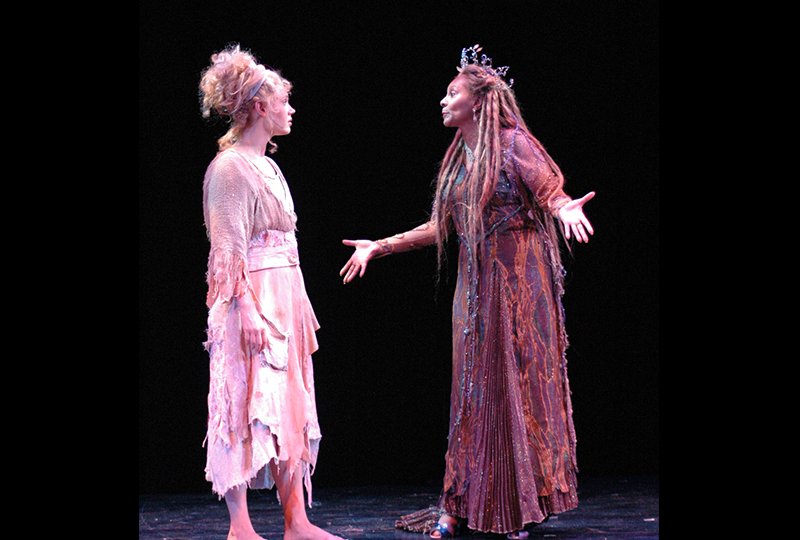
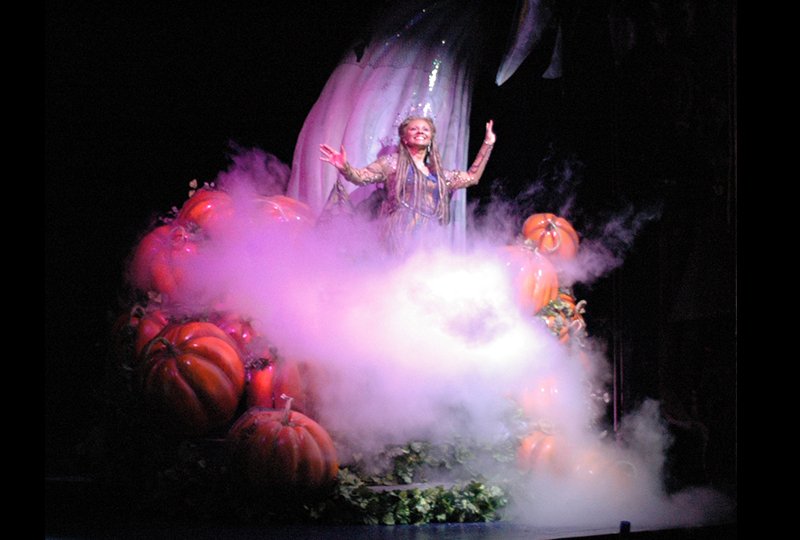
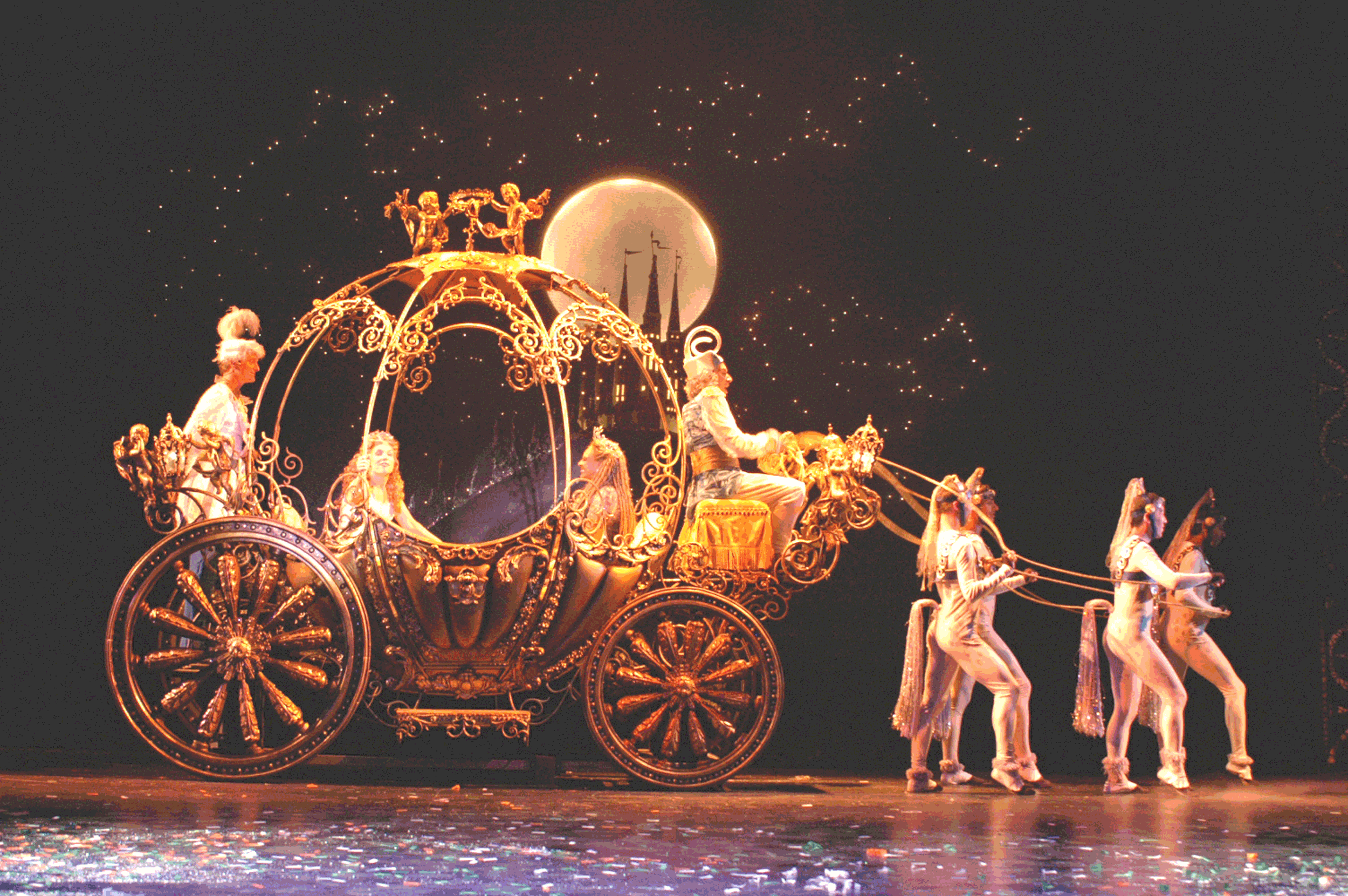
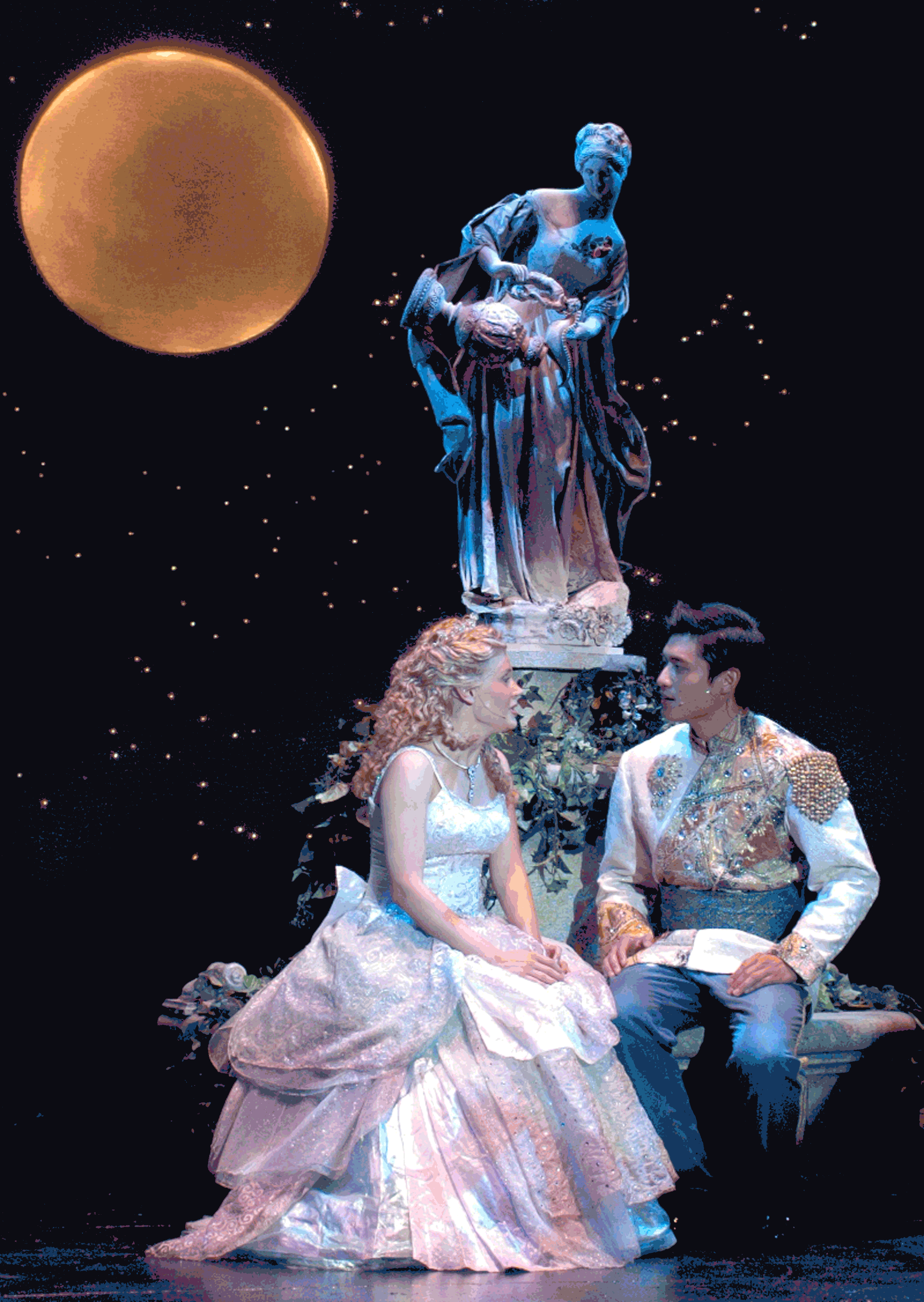
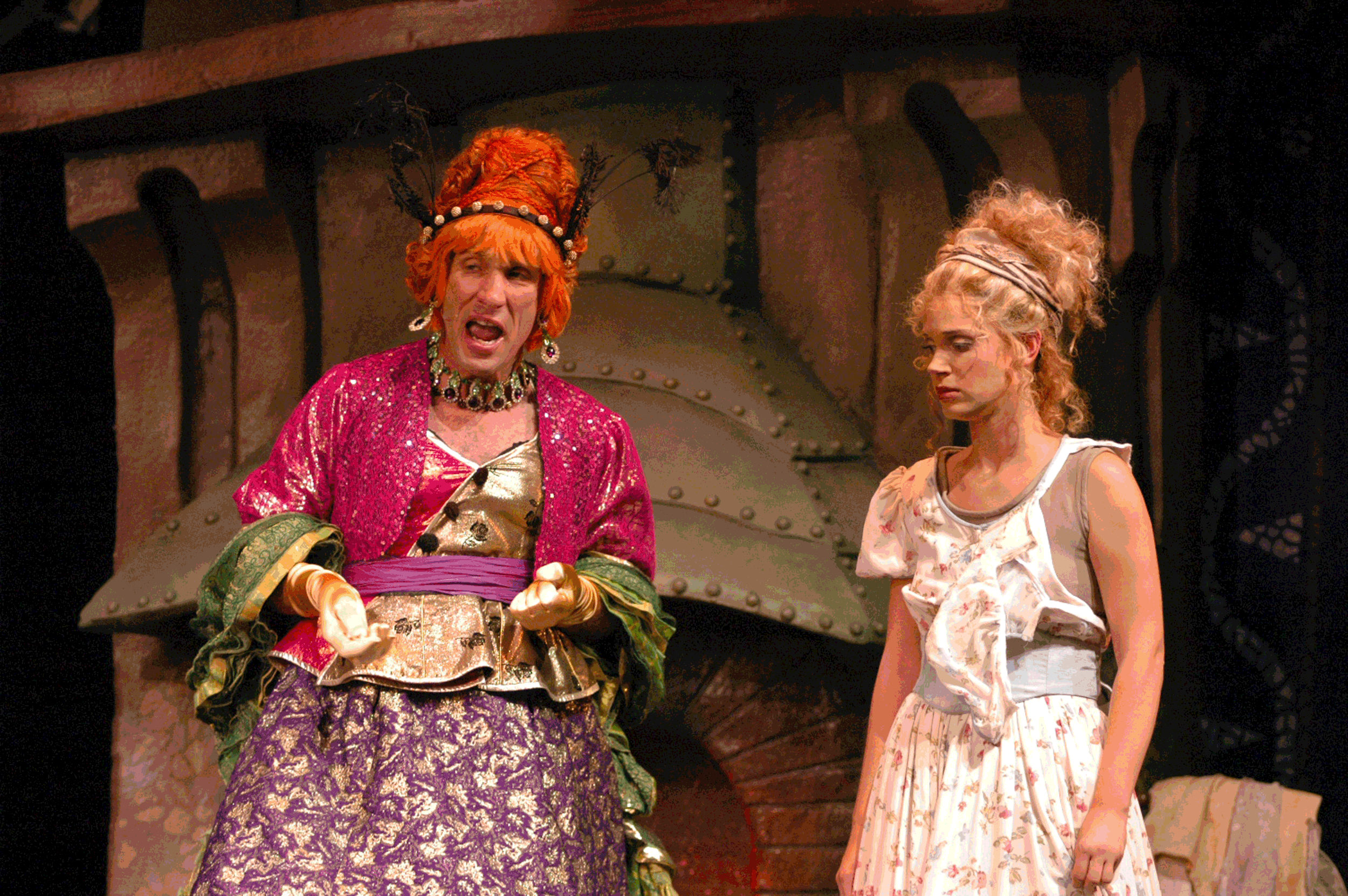
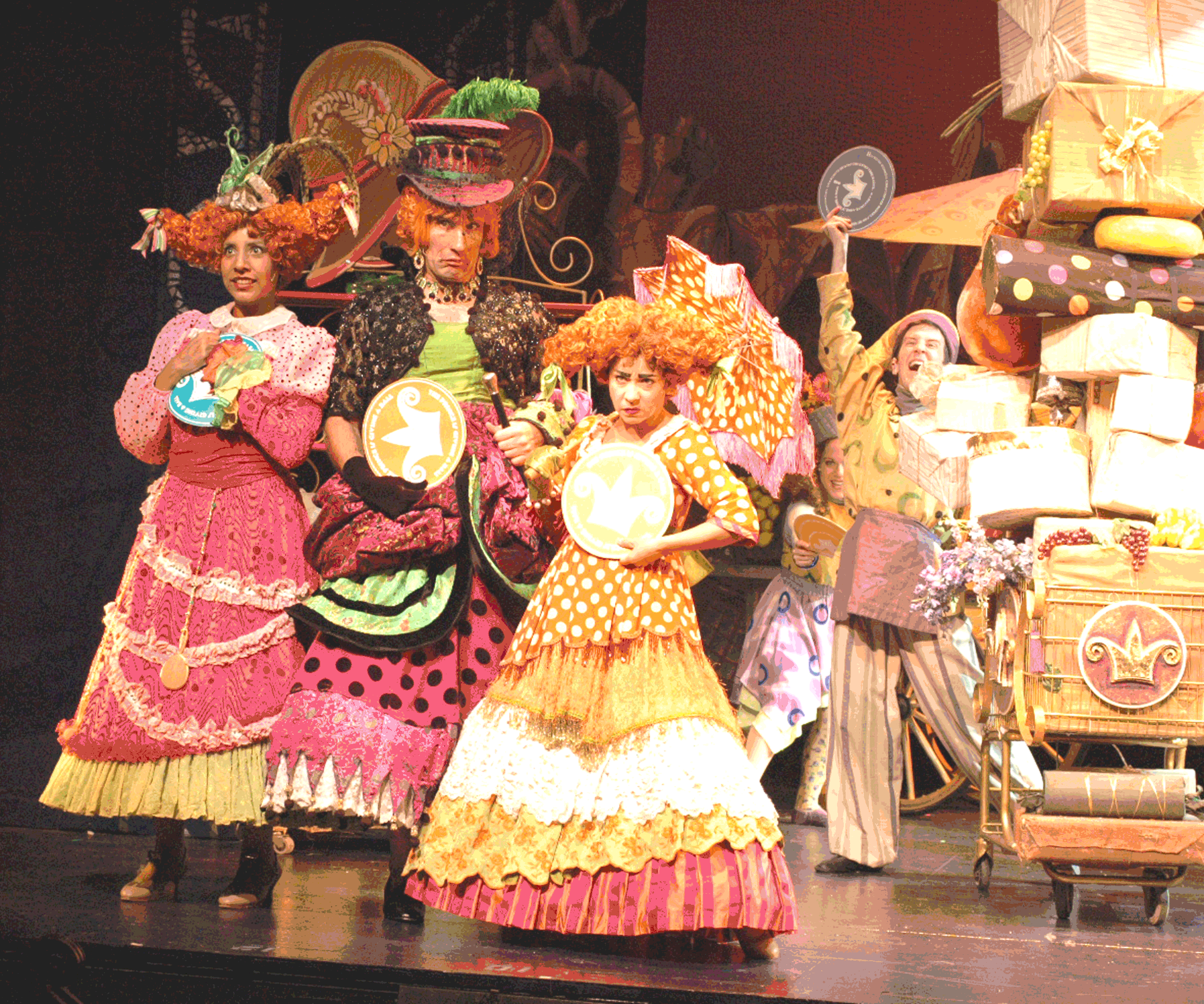
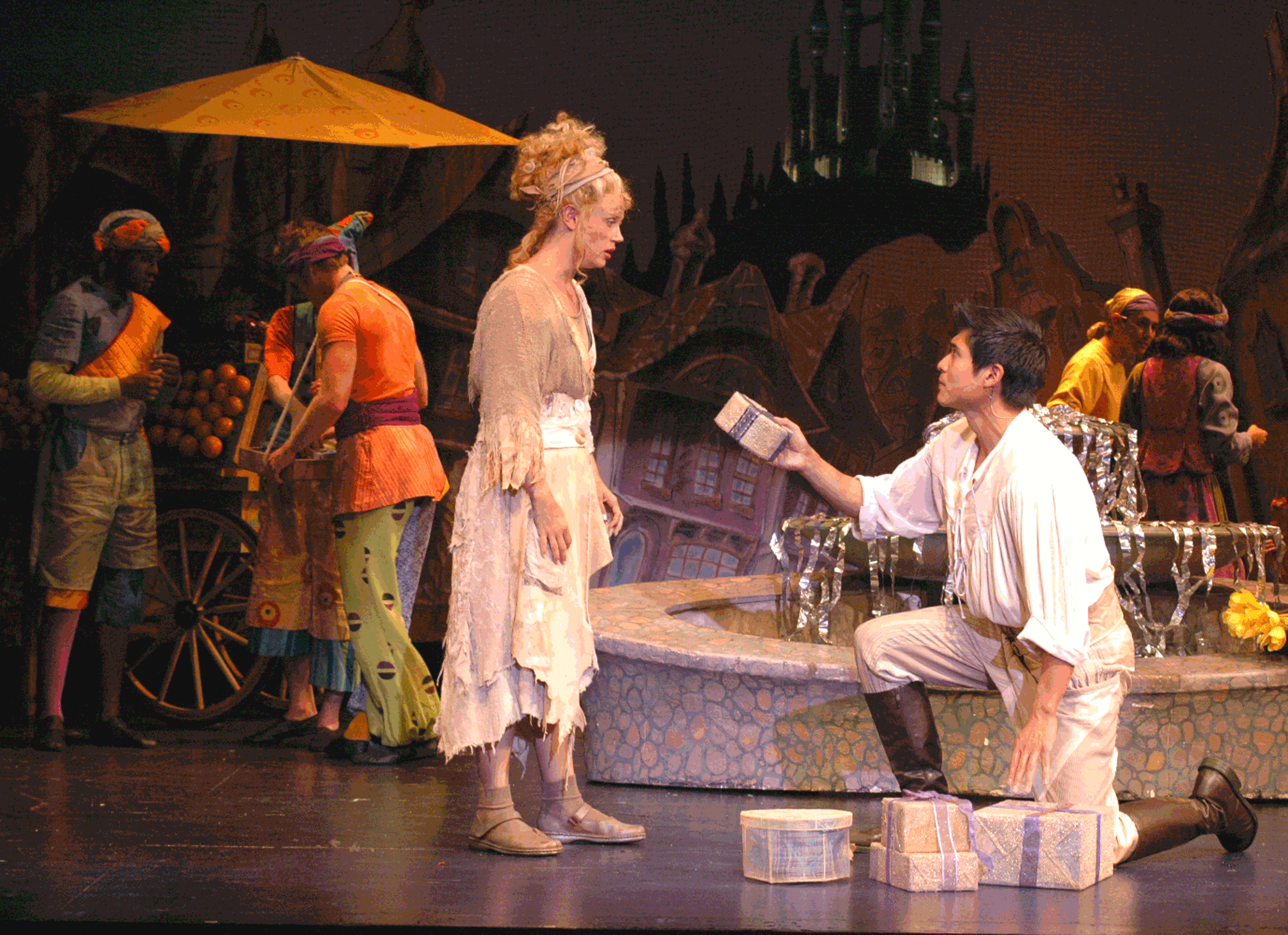
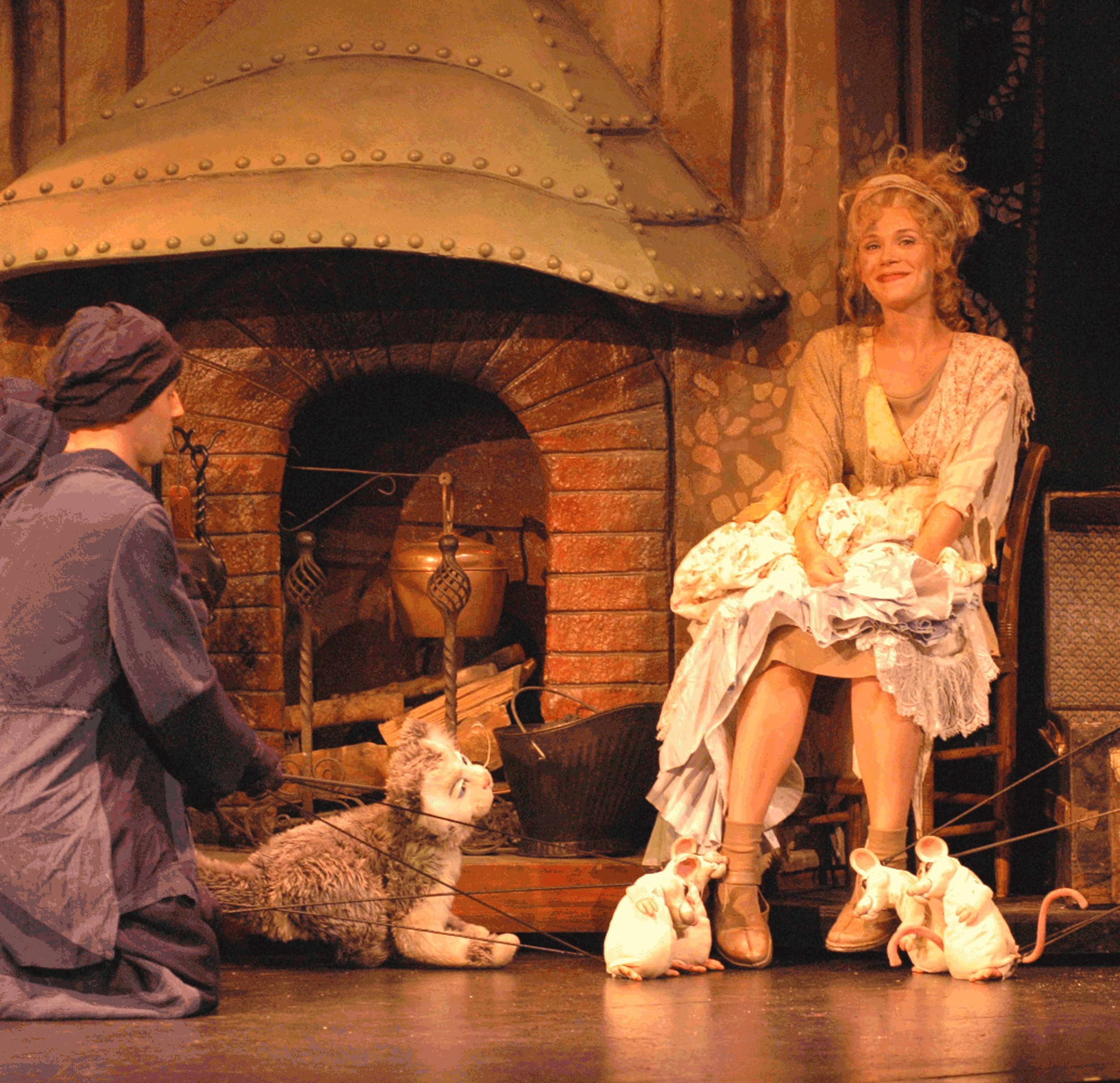
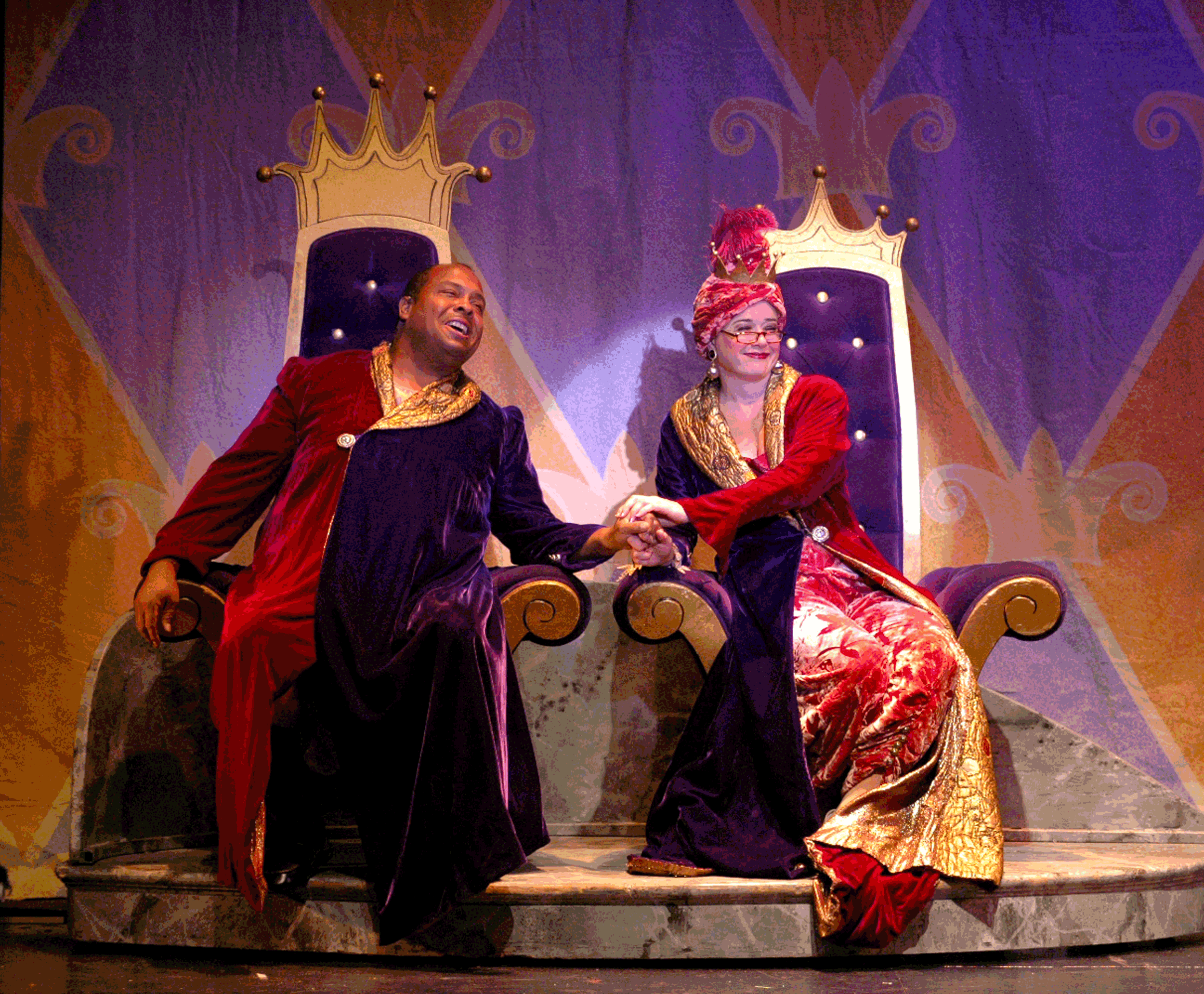
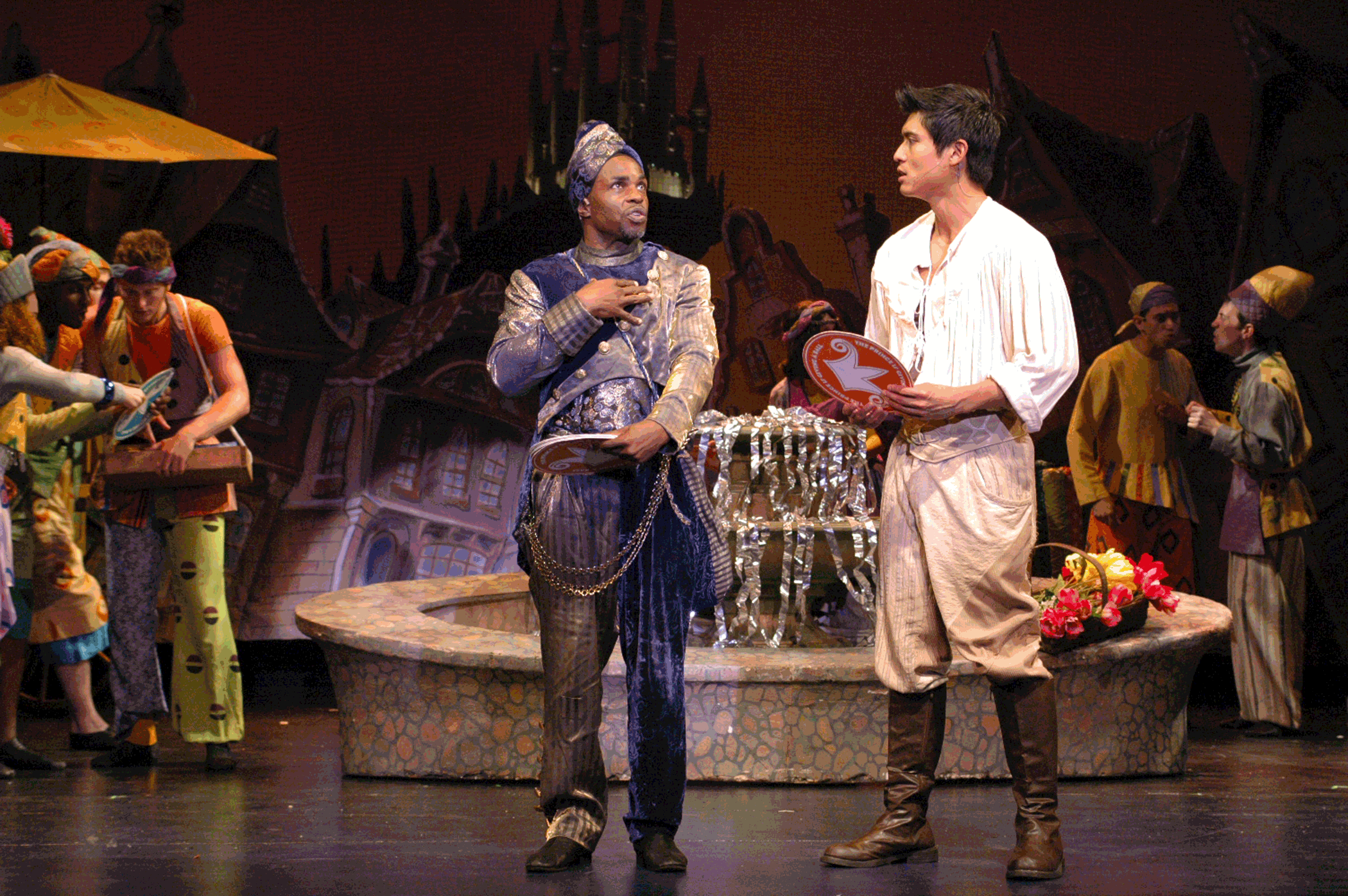
CINDERELLA
August 8 - 26, 2006
This fresh and exciting adaptation of Rodgers & Hammerstein’s 1957 made-for-television musical (which starred Julie Andrews) brings adventure, romance, and a miraculous kingdom to the stage. As the timeless fairy tale unfolds, a pumpkin turns into a golden coach, mice turn into horses, a dove becomes a footman, and a famously shabby maid sees her wildest dreams come true. Even if you know the ending, this quintessential classic will still have you asking, "Will the slipper fit?"
-
In 1956 Richard Rodgers and Oscar Hammerstein 2nd were indisputably the world’s most successful writers of musicals. Julie Andrews was a sparkling new star, having just triumphed in My Fair Lady When her agent approached Rodgers and Hammerstein and suggested that the television audience would welcome a musical version of Cinderella, it was an irresistible temptation for all.
Everything about the project was right from the start. The CBS production team was quickly assembled. Richard Lewine, a distant cousin of Rodgers and a close friend, was the producer, Ralph Nelson the director. Howard Lindsay and his wife, Dorothy Stickney, were signed for the King and Queen; Jon Cypher played the Prince; the Stepmother and Stepsisters were made less frightening and more comic by Ilka Chase, Kaye Ballard, and Alice Ghostley; rather than the standard old crone, the beautiful Edi Adams played the Godmother.
Rodgers and Hammerstein approached the story with the honesty and simplicity that characterized all their work. They purposely did not seek to improve a story they felt was dramatically sound, as many writers are prone to do, instead concentrating on bringing the characters to life. Rodgers wrote in his autobiography Musical Stages, “In writing the story and the songs, Oscar and I felt that it was important to keep everything as traditional as possible, without any ‘modernizing’ or reaching for psychological significance.” When Hammerstein was asked where he found the version of Cinderella story he based his adaptation upon, he answered, “I looked it up in the encyclopedia.”
The marriage of music, lyrics and story in Cinderella exemplifies their artistic philosophy that seemed so revolutionary in Oklahoma! and so natural with their latest show, The Sound of Music that it had become the form of most musicals. All elements held together integrally to illuminate the characters. As Rodgers explained, “Although a few of its songs have become popular, our score for Cinderella is another example of what theatre music is really about. No matter what the medium, a score is more than a collection of individual songs. It is, or should be, a cohesive entity whose word and music are believable expressions of the characters singing them. When the lonely, bullied heroine sings “In My Own Little Corner,” it’s not merely a song, it’s a revelation of the girl herself. When she finishes, we know something more about her than we had before—her sense of humor, her naïve optimism, her imagination and her relationship to the rest of her family. It is fair to say that this song is familiar to a vast number of people, but it has never made anyone’s hit parade and never will; it is simply part of a score, and it is the score in toto that either succeeds or fails. Like a symphony, concerto or opera, some portions have greater appeal than others, but it is the work as a whole that makes the overall impression.”
Cinderella in total succeeded. When it was broadcast on March 31, 1957, it was viewed by more people than any other program in the history of television.
-RNH.com
-
LESLIE UGGAMS (Fairy Godmother)
LESLIE BECKER (The Queen)
WILLIAM CABRERA (Ensemble)
JACQUE CANAHAN (Ensemble)
DANIELLE CHAMBERS (Grace)
BIEJE CHAPMAN (Ensemble)
JENNIFER CODY (Joy)
JOSEPH CULLINANE (Ensemble)
SUZANNE DRESSLER (Ensemble)
DAVID ILKU (Wicked Stepmother, Monday-Wednesday)
RYAN LANDRY (Wicked Stepmother, Thursday-Saturday)
STEPHEN LUKAS (Ensemble)
DOUGLAS LYONS (Ensemble)
STANLEY WAYNE MATHIS (Lionel, The Royal Steward)
PAOLO MONTALBAN (Prince)
WATNE W. PRETLOW (King)
FREDDY RAMIREZ (Ensemble)
JULIE REES (Ensemble)
JASON ROBINSON (Ensemble)
JESSICA RUSH (Cinderella)
CANDY SMITH (Ensemble)
DAVID TANKERSLEY (Ensemble)
CORINNE TIGHE (Ensemble)
EDDIE ZITKA (Ensemble)
BRADFORD T. KENNEY (Executive Artistic Director)
KIMBERLY STARLING (Associate Artistic Director)
GABRIEL BARRE (Director)
STEVEN YUHASZ (Associate Director)
FRED FRABOTTA (Musical Director)
JENNIFER PAULSON LEE (Choreographer)
JAMES E. CROCHET (Costumer Supervisor)
RICHARD ELLIS (Scenic Designer)
RICHARD LATTA (Lighting Designer)
ED THURBER (Sound Designer)
ROBERT LEVINSTEIN (Production Stage Manager)
ANDREA HOWARD (Assistant Stage Manager)
-
As a kingdom celebrates its Prince’s decision to give a ball for the express purpose of finding a bride, Cinderella’s two stepsisters and their mother enter. This less-than-lovable trio is followed by what seems to be a large pile of packages, but in fact is Cinderella carrying the ladies’ ball gowns, frills and frou frou from a successful shopping spree. Cinderella, it becomes apparent when they arrive home, will have the formidable job of making the Stepmother and Stepsisters beautiful for the ball—in addition to her other jobs, which include cooking, sewing, cleaning, washing and everything else imaginable. Although she won’t be allowed to go to the ball herself, Cinderella is happy for the others. She always tries to be cheerful and never complains. Sometimes, however, she retreats to her “own little corner” and dreams of a more exciting life.
The Queen and King are not in complete agreement about the Prince’s ball (which should in fact be called the Queen’s ball, since it is entirely her idea).The King doesn’t want to have it at all, since it will be a great deal of trouble, a large expense, and why would a red-blooded boy want to get married in the first place? But the Queen has her heart set on it, and neither the King nor the Prince (who dreads the whole idea) can bear to disappoint her. The preparations continue.
On the night of the ball, Cinderella helps her Stepmother and Stepsisters get ready. After they leave, she sits alone in her corner and imagines what it might be like at the ball. She’s not alone for long, however, for her Godmother appear at the window. Despite this lady’s sensible looks and practical manner, she is no ordinary godmother, though Cinderella doesn’t suspect this. With help from the Godmother’s “fol-de-rol” and “fiddley dee,” Cinderella is magically transformed for the ball. Her carriage, changed from a pumpkin, drawn by horses that were mice a moment before, whisks her to the palace.
The ball is the ball that everyone remembers from their storybooks, and Cinderella is the most beautiful of Princesses. Does she captivate everyone at the palace? She does! Do she and the Prince fall in love? They do! Must she flee at midnight before her carriage changes back into a pumpkin? She must!
Before she escapes, Cinderella loses her slipper, which the Prince retrieves. It is his only clue to finding her again, and he mounts a search for the foot that fits the slipper. All efforts are in vain, however. Even at the Stepmother’s house, the Godmother’s efforts to intervene for Cinderella are fruitless for Cinderella is nowhere to be found.
Meanwhile, the Prince has been trying to convince his mother (and himself) that he is not in love with a dream, but with a real girl, even if she has disappeared. When his is told that no one can be found whose foot fits the slipper, he is shattered. In anger he tosses the slipper into the bushes.
Cinderella, who herself can hardly believe her memories of the ball, has returned to the palace garden, hoping to recapture the magic of the night before, if only in her mind. The Prince stops her, but hardly recognizes the vision of loveliness he danced with underneath Cinderella’s sooty clothes and dirty face. She is embarrassed to be seen by him and tries to leave. For a moment it looks as if the story will end unhappily as she walks away, but at the last moment the Prince thinks to try the slipper on her foot (after the Godmother retrieves it and places it next to him). And, of course, the slipper fits.
Almost immediately the Royal Wedding begins. As the curtain falls on the happy couple, the Godmother reminds everyone that “Impossible things are happening every day.”
-RNH.com






